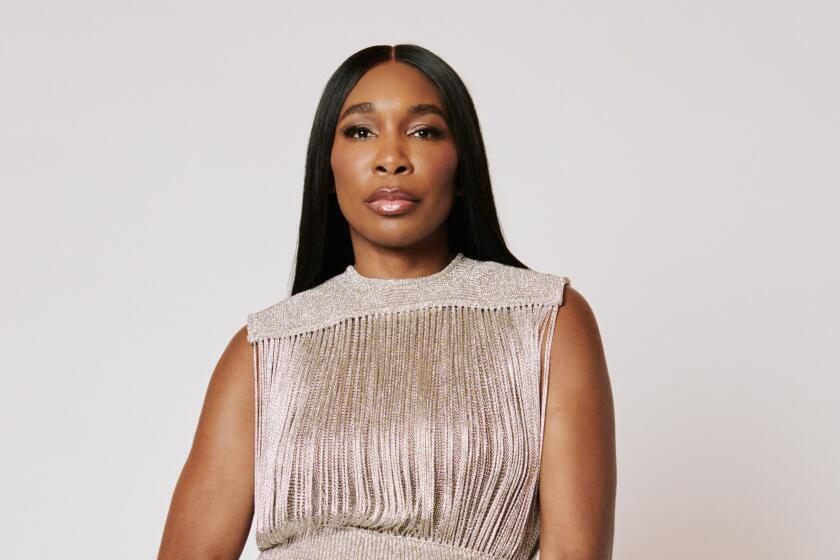Q&A: Richard McGuireâs âHereâ takes on a larger life as graphic novel
Richard McGuire has been making art in one form or another for close to 40 years. He recorded classic underground records with the band Liquid Liquid, produced PBS animations, directed French films, illustrated New Yorker covers and designed kids books and toys. He also created a one-off comic strip 25 years ago for Art Spiegelmanâs Raw magazine that is now being expanded into the time-traveling opus âHere,â a handsomely packaged graphic novel (Pantheon, 304 pp, $35) and e-book.
The printed volumeâs end pages recall Magritteâs painting âTime Transfixed,â in which a billowing black locomotive emerges from a fireplace. In âHere,â a fireplace becomes a metaphorical setting for everything that unfolds in that corner of the house, McGuireâs childhood home â fast-forwarding to a âBlade Runnerâ-like future with virtual reality everything and a predominantly Asian world population, and back in time 500 years for a glimpse of Native American Indiansâ first encounters with white men in New World New Jersey. In between, we witness a nuclear family not unlike McGuireâs own passing time, in conversation, telling and retelling jokes, engaging in domestic forgetfulness, as the seasons change and the 20th century plays itself out.
What started as a 36-panel comic strip more than two decades ago has morphed into one of the most engaging graphic novel experiments in book form Iâve ever seen: The print edition is a beautifully bound literary production, and the enhanced e-book allows you to skip back and forward in time as if you were watching an animated storyboard come to life. (âHereâ also opened as an exhibition this fall at the Morgan Library in New York City and was featured as a New Yorker cover.)
Speaking by phone from New York, McGuire discussed the unorthodox and drawn-out process that led to the book-length version of âHere.â
Youâre not a die-hard comics guy. Why release âHereâ as a graphic novel?
I can think of a few classic comics that really resonate with me. Thereâs only a small percentage of the stuff I can really connect with. Things like âKrazy Kat,â for instance. When I was a kid I used to cut out and rearrange the panels and make my own crazy story. But I was always much more interested in the art world. When Raw came out, it was significant enough that I was jealous and I wanted to be in it. I remember as soon as I made my first strip, I sent it to Art Spiegelman. That was âHere,â and it got in.
I met all those people. They all seemed like outsider artists. They seemed so not about making money. They were just making work for the love of it. I loved being part of that, but I felt like I had other things I wanted to do, and I never could totally commit myself to comics.
Itâs torture, making comics. The people who do it canât do anything else. Theyâre devoted. I could never just get totally behind it and do only that. Forever, I wanted to make an animated film, and I finally got to do it. I wanted to make toys and I was able to do that.
The original comic was 36 panels in Spiegelmanâs Raw 25 years ago. At what point did you start to think it should be a book?
After I had done that strip â I had only made a few strips in my life â I went off and did some kidsâ books. I took a trip to Japan, and I was coming back thinking about what I could do thatâs not a kidsâ book. It was before Chris Wareâs âJimmy Corriganâ had debuted.... He initially wrote me a fan letter, and then he came to New York. He was always after me to do more comics-driven work.
I made a little dummy and I went to the publisher ... it was Chris who opened the door there. I went over, showed them the stuff, and signed the contract, but I just couldnât wrap my mind around âHere.â
Iâm glad it didnât come out when it was supposed to. I wasnât ready for it. Also, on a personal level, my parents passed away, my sister passed away. We had to sell the house. I spent a lot of time in it digging through piles of stuff from my past. My parents lived there for 50 years. I had to sort it all out while I was working on the book, so it really flavored what I did. It wouldnât have been the same book at all if it had come out when it was scheduled to.
It seems cathartic in a way.
It was definitely cathartic. Also going through the grief stages helped. I got along with my family very well. Processing back-to-back loss was difficult. When I left the house, I took all these photos with me, and it was a weird way of dealing with it. I started to have all these dreams about them as I was working on the book. It was a very strange time. I spent a year doing research, and probably 11/2 to two years doing the artwork, trying to make it all make sense.
Simultaneously I was working on the e-book version, which ... re-contextualizes the book completely and makes new combinations and new connections.
Youâve said the book is about impermanence and the notion that now is the only thing that exists.
Thatâs the main take-away. ... I was scared of what to do for the future part of it and while I was working on it, two big events happened: the Fukushima and the Sandy Hurricane disasters. As I was thinking about that area, one thing I did know was that it goes underwater at some point in the future. Thatâs just the way the land is there. It had been underwater in the past and in the book it goes underwater twice in the future. But I didnât want a completely bleak future. There is some indication that there was some kind of disaster and radioactivity.
Are the visions of the future in the book why you consider it to be a work of fiction? Because itâs otherwise pretty autobiographical, is it not?
Yeah, I was afraid â especially when I was talking about it at the New York Public Library, people were saying some of the historical text should have been footnoted. But Iâm taking liberties.
I definitely did all the research, so I had a sense of grounding, but itâs not totally accurate. I had a motto when I was working on the book that I was making a big thing small and a small thing big. Itâs mostly about small, little things.
The domesticity depicted in the book drew me in. There are a lot of people telling jokes or looking for things they canât find or filling the awkward silences of everyday life. Without reading too much into it, is that why the book is so relatable, because itâs peppered with familiar everyday paradigms?
Yeah, I made lists and lists of these kinds of things. In the e-book version when some of them get reshuffled, I see things I didnât realize were there, or a theme emerges I hadnât thought about. I definitely think of the whole structure as being musical. I had it all up on my wall in my studio. I was shuffling around the pages constantly trying to get flows of things so they feel right. I wanted crescendos. Thatâs whatâs exciting about the e-book version, in particular, the way itâs shaking me up â to discover something new â every time I see it.
Gabel is a writer, editor and small publisher living in Los Angeles.
More to Read
Sign up for our Book Club newsletter
Get the latest news, events and more from the Los Angeles Times Book Club, and help us get L.A. reading and talking.
You may occasionally receive promotional content from the Los Angeles Times.









